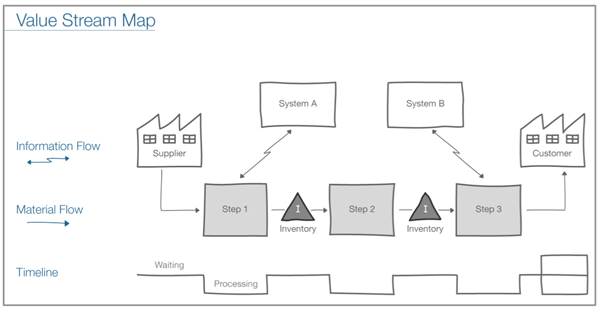How Leaders Focus on Value to Win
Note: Joakim Weidemanis and Frank Adegeest will conduct a workshop on Value Stream Mapping at the Consumer Goods Sales & Marketing Conference, which will be held June 5-7 in New York.
Don’t be mistaken: Lean concepts and tools are not just for the manufacturing floor. A diverse array of professionals is already realizing the benefits of extending "Lean" methods into non-manufacturing functions.
Just look at agile software development, agile marketing, and even agile careers: all stem from the rich source of the Toyota Production System (TPS). One of the fundamentals of TPS and Lean is "Value Stream Mapping," a powerful tool that can radically improve the flow of value in an operation.
Value Stream Mapping (VSM) helps leaders see through minutiae to understand what is really affecting the business. By focusing on a company’s value creation workflow, it exposes the waste and delays that exist in the current, real-time state. It is a clarity-driving event, a point from which to improve complex, cross-functional operations, whether in a single building or across continents.
A Value Stream Map is a visual representation of all the major process steps that create value for the customer and, in the end, complete a product or service. It is a representation of the current state of things, the real flow of materials and information from the customer’s request, through your organization and to delivery to the customer. It is derived from empirical evidence: real facts and figures. The current state motivates you to create a future state map and compose concrete actions to achieve it.

Here are four ways Value Stream Mapping can help you as a leader:
1. Inform decisions with empirical data. Because it is based on real numbers gathered from the people who actually do the work, VSM is grounded in reality, not opinions. Using real data avoids guess-timating ROI and makes plain the value of changing the workflow.
2, Enable a high-level evaluation. Taking a 10,000-foot perspective allows leaders to see and understand the entire workflow as a system of interconnected steps and activities, supported by real data. This big-picture perspective helps leaders set a strategy for improvement rather than trying to optimize on a piecemeal basis.
3. Identify and quantifiably prioritize opportunities for improvement. Finding waste is a good thing. It creates opportunities to improve your productivity and throughput — and as a result, your profitability. It also helps avoid incrementalism.
4. Correct root-cause problems. Rather than simply addressing symptoms, or quieting the loudest voice in the room, VSM helps you dig deeper to base targeted actions on real data, giving you confidence that countermeasures will actually produce results.
What are the results you can expect?
Simplification: When you focus on value, reduce waste and combine steps in your process, the whole value stream gets simpler.
Cost savings: When you reduce waste, you reduce labor costs as well as material costs.
Speed: This results from simplicity. And with real facts and figures, timeline improvements are measurable.
Quality Improvement: By focusing on value, you'll recognize the role quality plays in efficiency and renew your efforts to improve it.
Who is doing this well? A global CPG company reduced its packaging artwork lead time by 14 weeks. A UK-based pharmaceutical company reduced artwork- and packaging-related recalls by 50%. And a U.S. packaging printer shortened its delivery time to CPG clients by 14 days.
Danaher, a global science and technology innovator with 60,000 associates and revenues of $16.9 billion, itself uses Value Stream Mapping as part of the proprietary Danaher Business System, a toolset that enables continuous improvement focused on lean, growth and leadership. Danaher’s application of these tools — not just to manufacturing, but also to sales, marketing, service and even finance — has helped the company outperform the S&P 500 by over 1,000% over the past 20 years.
About the Authors
Joakim Weidemanis is vice president & group executive of the Product Identification Platform at Danaher and Frank Adegeest is director of R&D and product management at Esko.
Danaher serves consumer packaged goods manufacturers through the Product Identification Platform, a group of technology companies that helps clients reduce the cost of bringing products from concept to consumer by simplifying the packaging value stream. Including Esko, Pantone, X-Rite, Videojet Technologies, Linx, FOBA, and Laetus, these companies touch nine of every 10 packages sold at retail globally through software and hardware solutions for color selection and communication, product and packaging design and manufacturing, unique identification with marking and coding, as well as track and trace.
